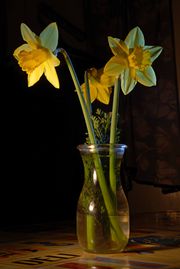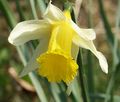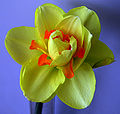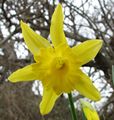Narcissus (plant)
| Narcissus | |
|---|---|
 |
|
| Scientific classification | |
| Kingdom: | Plantae |
| (unranked): | Angiosperms |
| (unranked): | Monocots |
| Order: | Asparagales |
| Family: | Amaryllidaceae |
| Tribe: | Narcisseae |
| Genus: | Narcissus L. |
| Subgenera, Species, Subspecies | |
|
See text. |
|
Narcissus (pronounced /nɑrˈsɪsəs/)[1] is the botanic name for a genus of mainly hardy, mostly spring-flowering, bulbs in the Amaryllis family native to Europe, North Africa, and Asia. There are also several Narcissus species that bloom in the autumn. Though Hortus Third [2] cites 26 wild species, Daffodils for North American Gardens[3] cites between 50 and 100 including species variants and wild hybrids. Through taxonomic and genetic research, it is speculated that over time this number will probably continue to be refined.[4] Daffodil is a common English name, sometimes used now for all varieties, and is the chief common name of horticultural prevalence used by the American Daffodil Society.[5] The range of forms in cultivation has been heavily modified and extended, with new variations available from specialists almost every year.
Contents |
Etymology & morphology
There are two derivations of the name. One is that of the youth of Greek mythology called Narcissus, who, in at least one of many variations of the tale, became so obsessed with his own reflection as he kneeled and gazed into a pool of water that he fell into the water and drowned. In some variations, he died of starvation and thirst from just sitting by the edge of the pool until he gave out, gazing at his reflection until he died. In both versions, the Narcissus plant first sprang from where he died. The other derivation is that the plant is named after its narcotic properties (ναρκάω narkao, "to grow numb" in Greek).[6]

There are several plurals in common use: "Narcissuses", "Narcissi", and "Narcissus". This last is common in American English but is very rare in British usage. The American Webster's Third New International Dictionary gives plurals in the order "Narcissus", "Narcissuses", and "Narcissi", but the British Compact Oxford English Dictionary lists just "Narcissi" and "Narcissuses".
The name Daffodil is derived from an earlier "Affodell", a variant of Asphodel. The reason for the introduction of the initial "d" is not known, although a probable source is an etymological merging from the Dutch article "de," as in "De affodil." From at least the sixteenth century "Daffadown Dilly", "daffadown dilly", and "daffydowndilly" have appeared as playful synonyms of the name.
The name jonquil is sometimes used in North America, particularly in the South, but strictly speaking that name belongs only to the rush-leaved Narcissus jonquilla and cultivars derived from it.
Flowers of the tazetta-group species Narcissus papyraceus are commonly called paperwhites.
Description
All Narcissus species have a central trumpet-, bowl-, or disc-shaped corona surrounded by a ring of six floral leaves called the perianth which is united into a tube at the forward edge of the 3-locular ovary. The seeds are black, round and swollen with hard coat. The three outer segments are sepals, and the three inner segments are petals. Though the traditional daffodil of folklore, poetry, and field may have a yellow to golden-yellow color all over, both in the wild species and due to breeding, the perianth and corona may be variously colored. Breeders have developed some daffodils with double, triple, or ambiguously multiple rows and layers of segments, and several wild species also have known double variants.
Toxicity
All Narcissus varieties contain the alkaloid poison lycorine, mostly in the bulb but also in the leaves.[7][8]
On 1 May 2009 a number of school children fell ill at Gorseland Primary School in Martlesham Heath, Suffolk, England after adding a daffodil bulb to soup during a cookery class. The bulbs could often be confused with onions, thereby leading to incidents of accidental poisoning.[8]
One of the most common dermatitis problems for florists, "daffodil itch" involves dryness, fissures, scaling, and erythema in the hands, often accompanied by subungual hyperkeratosis (thickening of the skin beneath the nails). It is blamed on exposure to calcium oxalate in the sap.[9][10] It has long been recognised that that some cultivars provoke dermatitis more readily than others. The cultivars 'Actaea', 'Camparelle', 'Gloriosa', 'Grande Monarque', 'Ornatus', 'Princeps', and 'Scilly White' and have proved particularly troublesome.[11]
Medicine
In kampo (traditional Japanese medicine), wounds were treated with narcissus root and wheat flour paste,[12] though it does not appear in the modern kampo herb list. The Roman physician Aulus Cornelius Celsus listed narcissus root in De Medicina among medical herbs, described as emollient, erodent, and "powerful to disperse whatever has collected in any part of the body". In one scientific study, the ethanol extract of the bulbs was found effective in one mouse model of nociception, para-benzoquinone induced abdominal constriction, but not in another, the hot plate test.[13]
Species
- Narcissus abscissus
- Narcissus alpestris
- Narcissus assoanus
- Narcissus asturiensis
- Narcissus atlanticus
- Narcissus aureus
- Narcissus barlae
- Narcissus bertolonii
- Narcissus bicolor
- Narcissus broussonetii
- Narcissus bulbocodium (Hoop-petticoat Daffodil)
- Narcissus calcicola
- Narcissus canaliculatus
- Narcissus canariensis
- Narcissus cantabricus (White Hoop-petticoat Daffodil)
- Narcissus cavanillesii
- Narcissus corcyrensis
- Narcissus cordubensis
- Narcissus cuatrecasasii
- Narcissus cupularis
- Narcissus cyclamineus (Cyclamen-flowered Daffodil)
- Narcissus cyprii
- Narcissus dubius
- Narcissus elegans
- Narcissus fernandesii
- Narcissus gaditanus
- Narcissus hedraeanthus
- Narcissus hispanicus (Spanish Daffodil)
- Narcissus italicus
- Narcissus jonquilla (Jonquil)
- Narcissus longispathus
- Narcissus macrolobus
- Narcissus minor (Lesser Wild Daffodil)
- Narcissus moschatus (White Daffodil)
- Narcissus nanus
- Narcissus nevadensis
- Narcissus nobilis
- Narcissus obesus
- Narcissus obvallaris (Tenby Daffodil)
- Narcissus ochroleucus
- Narcissus pachybolbus
- Narcissus pallidiflorus
- Narcissus panizzianus
- Narcissus papyraceus (Paperwhite Daffodil)
- Narcissus poeticus (Poet's Narcissus)
- Narcissus polyanthos
- Narcissus portensis
- Narcissus provincialis
- Narcissus pseudonarcissus (Wild Daffodil)
- Narcissus pumilus
- Narcissus radiiflorus
- Narcissus romieuxii
- Narcissus rupicola
- Narcissus scaberulus
- Narcissus serotinus
- Narcissus tazetta
- Narcissus tortifolius
- Narcissus triandrus (Angel's-tears)
- Narcissus viridiflorus
- Narcissus willkommii

Cultural importance
The Narcissus flower is perceived quite differently in the east than in the west. Whereas in the west, the Narcissus flower is seen as a symbol of vanity, in China, the same flower is seen as a symbol of wealth and good fortune. The ancient Greeks believed this plant originated from the vain youth, Narcissus. He died after becoming so obsessed with his reflection in a pool he could not leave. The Greeks say that the gods turned his remains into the Narcissus flower. This also led to the daffodil being a symbol of unrequited love. In ancient China, there is a legend about a poor but good man, who was brought many cups of gold and wealth by this flower. Since the flower blooms in early spring, it has also become a symbol of Chinese New Year. Narcissus bulb carving and cultivation is even an art akin to Japanese Bonsai. If your Narcissus blooms on Chinese New Years, it is said to bring you extra wealth and good fortune throughout the year. On top of that, it has one of the sweetest fragrances of any flower. So it is highly revered in Chinese culture.
In Hawaii, the Chinese Chamber of Commerce of Hawaii sponsors a Chinese cultural festival, called the Narcissus Festival, culminating with a beauty pageant whose winner is called the Narcissus Queen.[14]
The daffodil is the national flower of Wales. One species, Narcissus obvallaris, grows only in a small area around Tenby. In Wales it is traditional to wear a daffodil or a leek on Saint David's Day (March 1). This has led to suggestions that the word "daffodil" may have been influenced by the name "Dafydd," a Welsh form of "David" (see Etymology). However, in Welsh, the daffodil is known as Cenhinen Bedr (Peter's Leek).
In some countries the yellow variation is associated with Easter. The German for daffodil is Osterglocke, that is "Easter bell."
William Wordsworth's short poem "I Wandered Lonely as a Cloud" has become linked in the popular mind with the daffodils that form its main image.
In the movie Big Fish, Edward Bloom plants a field of daffodils outside of Sandra Templeton's window in order to win her heart.
In Ridley Scott's Alien, the Nostromo's shuttle craft in which Ripley played out the final battle with the alien was called Narcissus.
In Tennessee Williams' The Glass Menagerie, Amanda Wingfield carries in a bunch of jonquils, a type of daffodil, in her preparation for the Gentlemen Caller. She then reminisces that when she was young, and had many gentlemen callers, she was showered in jonquils by her many admirers.
There is a Daffodil Festival in Nantucket, MA the last weekend in April of every year. In this celebration of spring hundreds of antique cars are adorned with thousands of daffodils.
The British Band The Cranberries have a song called "Daffodil Lamment".
Daffodils are a part of E. E. Cummings' poem, "in a time of daffodils".
Freddie Mercury has been quoted as saying "I'm as gay as a daffodil, my dear."[15]
In the visual novel Narcissu, which is named after the flower, a pair of patients with terminal illnesses (one with cancer) escape from hospice to journey to an island filled with daffodils. The Greek myth of Narcissus also serves as a metaphor in the novel.
In an episode of Futurama, "Daffodil" appears mysteriously as number two on Bender's most commonly spoken words. Daffodils are also a recurring visual gag, usually described as everyone's favorite flowers and are the only flowers most characters present others with.
In the manga and anime series Bleach, the insignia for the Tenth Division is the daffodil; the meaning behind it is Mystery, Egoism.
The American superband Them Crooked Vultures has a song called "Spinning in Daffodils"
The Daffodil was voted the county flower of Gloucestershire following a survey by the wild flower and plant conservation charity, Plantlife.[16]
Symbol of Cancer Research

Various cancer charities around the world use the daffodil as a fundraising symbol. "Daffodil Days" are organized to raise funds by offering the flowers in return for a donation. The Canadian Cancer Society was the first to institute Daffodil Days in Toronto in 1957.[17]
Other organisations to have adopted the daffodil as a symbol for fundraising include:
- American Cancer Society[18]
- New Zealand Cancer Society[19]
- The Cancer Council Australia[20]
- Irish Cancer Society[21]
- Marie Curie Cancer Care[22]
Horticultural divisions
The American Daffodil Society - ADS [23] divides all Narcissus into 13 horticultural divisions, based partly upon flower form and partly upon genetic background. Since the ADS Web site is written for general consumption, the text of the descriptions contained there is relatively broad.[5] Horticulturist Robert F. Gabella of GardenOpus has further clarified herein these definitions by replacement of the words "cup" with "corona", "petals" with "perianth segments", and clarified corona length and corona radius for cases where the corona does not protrude outward. Gabella has further emphasized the prevalence of species phenotype comparable to the genetic lineage of ADS Divisions 5 through 10, and has also called out garden and/or wild origin.[4]
The divisions are:
- Division 1: Trumpet Daffodils. Plants are of garden origin. Corona length is equal to or exceeds the length of the perianth segments, flowers are borne one to a stem.
- Division 2: Large-cupped Daffodils. Plants are of garden origin. Corona length, or corona radius if flattened, is more than 1/3 but less than equal to the length of the perianth segments; flowers are borne one to a stem.
- Division 3: Small-cupped Daffodils. Corona length, or corona radius if flattened, is no more than 1/3 the length of the perianth segments; flowers are borne one to a stem.
- Division 4: Double Daffodils. Any daffodil in which more than one layer of perianth segments and/or more than one layer of corona segments are present. The combination of doubled perianth and corona segments can vary widely between cultivars, and there may be one or more flowers per stem, also varying by cultivar.
- Division 5: Triandrus Daffodils. Characteristics of Narcissus triandrus and its allies clearly evident; flowers hang more or less downward, perianth segments are often reflexed, and plants most often bear two or more flowers per stem.
- Division 6: Cyclamineus Daffodils. Characteristics of Narcissus cyclamineus and its allies clearly evident; perianth segments are often reflexed or wind-swept in appearance, corona length varies but can sometimes exceed the perianth segment length, and flowers are borne one to a stem.

- Division 7: Jonquilla Daffodils. Characteristics of Narcissus jonquilla and its allies clearly evident; flowers are small to medium sized, perianth segments are flat, corona length varies but is usually short and semi-spherical, foliage may be rush-like and dark green as in the species but phenotypic distillation through crossbreeding between divisions has produced a range of foliage types. Fragrance is usually prominent. Flowers may be borne one to several to a stem, depending upon cultivar.
- Division 8: Tazetta (Poetaz or Bunch-flowered) Daffodils. Characteristics may be intermediate between Narcissus tazetta and its allies and/or N. tazetta in combination with Narcissus poeticus is ambiguously evident. Perianth segments are flat, corona length is usually short and semi-spherical. Fragrance is usually prominent. Flowers may be borne in clusters of a few to over a dozen per stem, depending upon cultivar.

- Division 9: Poeticus (Poet's) Daffodils. Characteristics of Narcissus poeticus and its allies clearly evident; flowers are medium sized, perianth segments are flat and nearly always white, corona is small, flat, and wrinkled—usually green eyed and orange-to-red banded—often with intermediate shades of yellow. Fragrance is usually prominent. Flowers are usually borne one, but very occasionally two, to a stem.
- Division 10: Bulbocodium Daffodils. Characteristics of Narcissus bulbocodium and its allies clearly evident; flowers are small, perianth segments are small, linear to awl-shaped, corona is very large in proportion to the perianth and "hoop petticoat" or bowl shaped, foliage is usually rush-like and dark green as in the species. Flowers are borne one to a stem.
- Division 11: Split-corona Daffodils. Plants are of garden origin and can represent any potential genetic background. The corona, which can be any length or orientation, is radially split from the outer rim inward at more than half its natural length. The splitting can occur triradially or hexiradially, and in some cases the segments may be broad enough to underlap and overlap alternating perianth segments. Though flowers are most often borne one to a stem, there are cultivars with multiple flowers per stem. Division 11 is subdivided as follows:
- a) Collar Daffodils. Corona segments lie opposite the perianth segments and are usually in two whorls of three.
- b) Papillon Daffodils. Corona segments lie alternate to the perianth segments and are usually in a single whorl of six.
- Division 12: Miscellaneous Daffodils. Any daffodils of garden origin not classifiable by the first 11 Divisions. They may be inter-division hybrids, or of such ambiguous heritage or phenotype that they do not easily fit into any of the above divisions. This includes the dwarf daffodil "Tete-a-Tete".
- Division 13: Species, Wild Variants and Wild Hybrids. All Daffodils occurring naturally in the wild. Plants of the preceding 12 divisions are all of garden origin.
- Miniature Daffodils - Miniature Daffodils are not an official ADS Division; miniatures can occur in each of the other 13 Divisions and possess the same descriptive characteristics. However, the flowers are 1.5" or less in diameter, and ideally are borne on proportionally smaller plants.
Color range and classification
Daffodils may be self-colored—i.e., both perianth and corona identical in color and shade—or the colors between the perianth and corona may differ widely. Some perianths and some coronas also may contain more than one color or shade. Prevalent colors are all shades and tones of yellow, white, orange, pink, red and green. Pinks vary from apricot to rose in shades from pale to deep, and some more recent cultivars have hints of lavender or lilac. Reds vary from orange-red to salmon red to near scarlet. Pink, red, orange and green tones are mainly confined to the corona. However, breeders are currently working against the genera's natural pigmentation and genetic barriers to create cultivars in which pink, rose, red, orange and green tones suffuse or "bleed" from the more highly colored coronas onto the perianth segments of white or yellow. There are an increasing number of commercially available varieties which display this enhanced coloration.
- ADS Color Classification:[5]
- W = White or whitish
- G = Green
- Y = Yellow
- P = Pink
- O = Orange
- R = Red
The flower's two regions are assigned color somewhat differently. The perianth colors are assigned from (in the case of multiple colors) the outer edge of the segment inward to the base of the corona. The corona colors are assigned from the base of the corona outward to the rim. Thus, Actaea, a Poeticus (Division 9) Daffodil, is officially classified as 9 W-GYR, while Accent, a Large Cup (Division 2) Daffodil possessing a white perianth and a pink corona, is officially classified as 2 W-P.
Gallery
 |
_-_8.jpg) |
 |
 |
|
 |
 |
 |
 |
 |
 |
 |
 |
 |
 |
References
- ↑ Sunset Western Garden Book, 1995:606–607
- ↑ Hortus Third, Staff of The L. H. Bailey Hortorium, Cornell University, 1976, pp. 754-756. (Macmillan Publishing Company, NY, NY; ISBN 0-02-505470-8)
- ↑ Daffodils For North American Gardens, Brent and Becky Heath, 2001, (Bright Sky Press, Albany, TX; NY, NY; ISBN 0-9704729-7-8)
- ↑ 4.0 4.1 GardenOpus
- ↑ 5.0 5.1 5.2 American Daffodil Society - ADS
- ↑ "?". http://www.botanical.com/botanical/mgmh/n/narcis01.html.
- ↑ Food and nutrition Daffodil dinner David Trinklein, Department of Horticulture, University of Missouri, Accessed March 2008
- ↑ 8.0 8.1 "Pupils ill after bulb put in soup". BBC News. 2009-05-03. http://news.bbc.co.uk/1/hi/england/suffolk/8031344.stm. Retrieved 2010-03-27.
- ↑ Floridata: Narcissus spp
- ↑ Electronic Textbook of Dermatology-Botanical Dermatology , Occupational Plant Dermatoses
- ↑ Narcissus in BoDD – Botanical Dermatology Database
- ↑ Carmen Altomonte. "Kampo — The Japanese Art of Herbal Healing". http://www.ittendojo.org/articles/general-8.htm.
- ↑ PMID 9379365
- ↑ "?". http://www.narcissusqueen.com.
- ↑ Queen Frontman, Freddie Mercury Ramon Johnson, about.com, Accessed November 2008
- ↑ County Flowers of the UK
- ↑ Canadian Cancer Society Daffodil Days
- ↑ Daffodil Day
- ↑ Daffodil Day
- ↑ Daffodil Day
- ↑ Daffodil Day
- ↑ Daffodil Appeal
- ↑ "?". http://daffodilusa.org.
